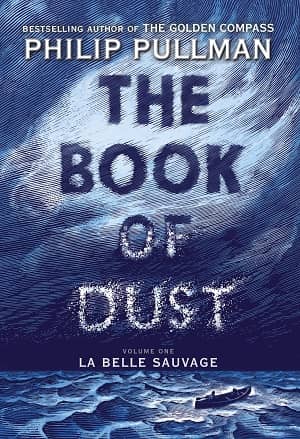Seventeen Years Later, Return to His Dark Materials: The Book of Dust: La Belle Sauvage by Philip Pullman
 The venerable Philip Pullman returns to the universe of the classic His Dark Materials series after 17 years with his latest fantasy, The Book of Dust: La Belle Sauvage. As a longtime fan of the saga, I thoroughly enjoyed this chance to return to his steampunk alternative “Brytain,” with its changeable daemons, anbaric lamps, peculiar gadgets, and peripatetic intellectuals. Opening this book felt like being wrapped in a blanket and having tea around a fire with old friends.
The venerable Philip Pullman returns to the universe of the classic His Dark Materials series after 17 years with his latest fantasy, The Book of Dust: La Belle Sauvage. As a longtime fan of the saga, I thoroughly enjoyed this chance to return to his steampunk alternative “Brytain,” with its changeable daemons, anbaric lamps, peculiar gadgets, and peripatetic intellectuals. Opening this book felt like being wrapped in a blanket and having tea around a fire with old friends.
Surprisingly mature, well-mannered and handy eleven-year-old Malcolm Polstead is a natural spy, since working at his parents’ riverside inn gives him access to all manner of travelers and their gossip. When three dangerous visitors arrive, he’s swept into a secret war against the forces of arrogant religious authority.
Joining a shadowy resistance movement, he risks his life to protect a baby who’s prophesied to change the world. At first, this means thwarting villains’ attempts to kidnap her. But then a hundred-year flood devastates the town, and he must grab her from her cradle – already floating – and ride the surging waters in his trusty canoe, La Belle Sauvage, which is the title of this first volume in the series.
The baby herself? Her name is Lyra. Yes, The Book of Dust: La Belle Sauvage is a prequel.
The Book of Dust: La Belle Sauvage was published in October 2017 and spent 13 weeks on the New York Times bestseller list for YA Hardcover, finally slipping off at the end of January 2018. Yet I would argue that it isn’t really a YA book as conventionally understood, and that adults are its natural audience. After all, we are the ones most likely to revel in its slower pace and sly tendency to say one thing while meaning another.
Moreover, the official target audience for YA is 12 to 18, and teenagers are notorious for wanting to “read up” about people older than them. Malcolm’s age, at only eleven, would make him more naturally a “Middle Grade” hero. Yet the novel’s content is probably too subtle and sophisticated for such young readers.
Perhaps the book’s success is explained by the fact that most people who buy YA for their own reading pleasure actually are adults. According to a 2012 Publishers Weekly article,
Fully 55% of buyers of works that publishers designate for kids aged 12 to 17 – known as YA books – are 18 or older, with the largest segment aged 30 to 44, a group that alone accounted for 28% of YA sales. And adults aren’t just purchasing for others – when asked about the intended recipient, they report that 78% of the time they are purchasing books for their own reading.
While The Book of Dust: La Belle Sauvage is an enjoyable read on its own, it’s clearly intended to springboard the reader into the rest of the series. According to Wikipedia’s entry on The Book of Dust, the second volume will be entitled The Secret Commonwealth and is rumored to feature Lyra’s travels as a twenty-year-old undergraduate.
The Book of Dust: La Belle Sauvage was published by Knopf Books for Young Readers on October 19, 2017. It is 464 pages, priced at $22.99 in hardcover and $11.99 for the digital edition. It is Book 1 of The Book of Dust. To read an excerpt, point your browser at The Guardian.
Elizabeth Galewski is the author of The Wish-Granting Jewel, a fantasy novel, and Butterfly Valley, a tale of travel and transformation based on true events. To learn more, please visit her official author’s website at www.elizabethgalewski.com.
Taken as a whole, His Dark Materials is my all-time favorite book.* I originally bought each volume as they came out, because one of the Washington Post’s main book critics was a huge fan, but I didn’t read them until the movie came out. Some might not have liked it, but I rather did, and wish the movie series had continued with the same actress. The series is poetic, beautifully written, and immensely creative, and I think about it often.
I am waiting for all of the second trilogy to come out before reading, though the wait is difficult to be sure.
*–It may be a co-favorite with Danielewski’s House of Leaves, which has a fine understanding of claustrophobia—something I have—and why even huge, open spaces can trigger it if there is no way to get out of them.